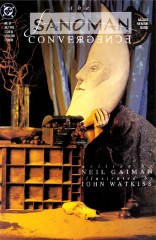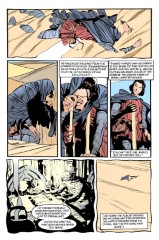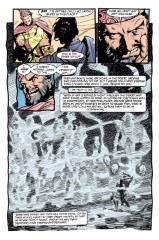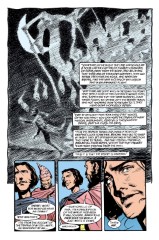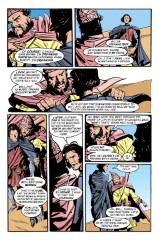Issue 39: "Soft Places"
Neil Gaiman and John Watkiss
- Second story in anthology, Convergences
- Sixth story reprinted in trade paperback Fables & Reflections
- Audible Act II Chapter 19
Themes: Convergences is about storytelling, as is Sandman overall. In particular, Convergences tells tales where the storyteller becomes the story, and where reality intersects with story and with fantasy. And, it may be noted, dreams are where reality and fiction converge.
A common thread among the stories is the intersection (or convergence) of characters with their own divergent lives. Another is the passage from the familiar to the unfamiliar, as happens to the central character in each story. Also, in each tale, the central character is not a native to the Dreaming but visits a portion of it in the process of the tale. One may also note the role of time in each tale, encompassing some aspect of the past, the present, and the future.
In "Soft Places", Marco Polo travels into a soft place unfamiliar to him, as he also travels from familiar Europe to unfamiliar Orient. Additionally, we note the convergence between story and storyteller as Marco meets his biographer. The present, such as it is in a soft place, is the meeting between two past men and a future man. This issue, otherwise, is fairly soft in the thematic area.
Page 1#
Panel 1
Anno Domini: Year of Our Lord, Latin, usually represented as the more familiar A.D.
Marco is Marco Polo (c.1254-1324, making him about 17), a Venetian traveler. He is noted for having left a long and detailed account of his travels to Cathay and the court of the Mongols. Although there are records of other Europeans having traveled to the Orient, notably Marco's father and uncle, Marco's document was widely read and inspired much of the West's later dealings with the Far East.
Page 4#
Panel 4
This is the "standard" folkloric visualization of the Sandman - E. T. A. Hoffman wrote a short novel named "Der Sandmann" (The Sandman) in which this picture of the Sandman is presented Henrik Ågren Henrik.Agren@hist.uu.se; can anyone fling me some other good refs?
Page 5#
Panel 3
The song is an old jazz tune named "I'll be glad when you're dead, you rascal you". The most famous recordings of this song is by Louis Armstrong. It is said that the song was dedicated by him to a police officer who once harassed him at the way to the recordings.
I don't know if this is true, but the story is told in Mezz Mezzrow's book about Chicago jazz "Really the blues".
The point is that "I'll be glad when you're dead, you rascal you" is from the same era as the other two songs.
I also know that Louis Armstrong has recorded "Bill Bailey". Maybe Marco is passing the reflections (or something like that) of a jazz club of the 20s or maybe even a Louis Armstrong show. (Henrik Ågren Henrik.Agren@hist.uu.se)
Panel 4
"Bill Bailey Won't You Please Come Home?", by Hughie Cannon, 1902.
Panel 5
"How You Gonna Keep 'Em Down on the Farm After They've Seen Paree?", lyrics Joe Young, music Walter Donaldson, 1919, a song of the First World War, referring to rural soldiers who'd gotten their first look at the sophistication of urban life.
Panel 6
The first song is "Brother, Can You Spare a Dime?", lyrics Edgar Y. Harburg, music Jay Gerney, 1932, a song of the Great Depression. The others are unknown.
Page 7#
Panel 1
The Desert of Lop ("Lop Nar" or "Lap Nor") is located in central China, and has been used as the People's Republic's nuclear testing ground.
Page 7-8#
The quote is taken directly from The Travels of Marco Polo; one useful edition (in which the translation is nearly word for word the text here) is published by Penguin, translated by Ronald Latham. In the paperback edition, the quote starts on page 84. The translator identified the Desert of Lop as the current-day Gobi Desert. Polo says the desert is named after a nearby city, which the Penguin edition tentatively identifies as the city of Charklik in modern Turkestan.
The lengthy introduction to this edition has quite a lot of information about Polo's life, and discusses Rustichello at some length.
Page 8#
Panel 3
When Marco Polo was taken prisoner in a battle between Venice and Genoa, he told the tales of his travels to his cell-mate, Rustichello, who recorded them in the book The Travels of Marco Polo.
Page 9#
Panel 6
No refs on Shangtu. Presumably a city in China, possibly an obsolete name. There have been several systems of transliteration from Chinese to English, complicating the issue.
Page 10#
Panel 3
This is Gilbert, aka Fiddler's Green, last seen in The Doll's House.
Panel 4
Soft places: Explained later.
Panel 5
Nicolo, Maffeo Polo: These are indeed Marco's father and uncle, respectively. This is a return trip to the East for them; they had previously visited Khaifeng in China.
Panel 6
Beaujolais: A fruity Burgundy wine, named after the region in France where it is produced. Tokay: See Annotation 38; a sweet wine from Tokay in Hungary. Note the convergence of storytellers.
Page 11#
Panel 2
Jelly babies: A soft chewy candy native to the British Isles. The fourth incarnation of the Doctor on the British series Doctor Who always carried a bagful of jelly babies as a well-known trademark.
Gilbert, though patterned after G.K. Chesterton, has some points of appearance and manner in common with the Doctor.
Panel 5
Gilbert is a place, not a person, though he occasionally takes human form.
Panel 6
In the last issue we saw Dream sympathetic to romance; here we learn that he is engaged in a new one, though the reciprocant of his affection is as yet unnamed. This helps pinpoint that Gilbert is talking to us from the "present" of the comic.
Page 12#
Panel 1
Constantinople: Named after the Emperor Constantine, the former name of the Turkish city Istanbul. At this time, the city had recently been retaken from the Crusaders by the Greeks, and was once again the capital of the Byzantine Empire.
Panel 2
Kublai Khan: Grandson of Genghis Khan and expander of his empire, and founder of the Mongol dynasty of China. The Khan is familiar to Western audiences partly through the poem "Xanadu", which came complete in a vision to the author, Samuel Coleridge, in an opium-induced dream.
Shangtu is (in correct PinYin romanisation) the name of the Mongol's first capital city after they conquered the Chinese empire. It flourished for 50 or so years in the thirteenth century before the capital was moved south and modern Peking/Beijing built. Marco Polo visited China during the brief period when Shangtu was capital and described it in detail. The site exists today as dramatic ruined earthworks in Inner Mongolia. It is the original 'Xanadu' of western Romantic poetry.
Panel 5
The Khan's request for one hundred Christian scholars and technicians is historically accurate, including its answer. Gautama Buddha: Indian religious leader and founder of Buddhism.
Page 13#
Panel 2
Saint Joseph of Copertino [sic]: From the Dictionary of Saints:
1602-1663. Joseph Desa was born in Cupertino, near Brindisi. He tried his vocation several places, but was summarily dismissed on account of his 'poor intelligence.' Finally he was received by the Conventional Franciscans of Grotella as a stable-hand and a lay tertiary. On account, however, of the rare spiritual gifts which now began to be manifest in him, he was professed as a friar and duly ordained priest. From this time on his life is an amazing, and perfectly authenticated, succession of preternatural phenomena. The most remarkable of these was his power of levitation: he would fly straight from the church door to the altar over the heads of the worshippers; once he flew to an olive tree and remained kneeling on a branch for half an hour. Happenings like these were almost every day occurrences, witnessed by hundreds of persons. Withal he was a simple, gentle, humble follower of St Francis. His brethren, however, resented so much publicity, and on this account the saint had much to suffer from them. Canonized in 1767.
His flights occurred during heights of religious ecstasy; he was known as the "flying friar". He flew in public before popes and kings, including the Duke of Bavaria, who converted after seeing the miracle. Additional information from Powers of Darkness, Powers of Light: St. Joseph came from an area of Italy where the tarantula is performed, a dance including many high leaps. It is thought that this may have been mistaken for flying. In the practice of self-mutilation, he beat himself so severely there was blood on the walls of his cell, 20 years after his death. He placed black powder on all his food before he ate it, which would cause anyone else who ate it to be violently ill. It has been suggested that the powder contained the fungus ergot, which causes hallucinations. He is also said to have regularly eaten leaves filled with the pus from lepers' sores.
The Franciscan order is an order of monks affiliated with the Roman Catholic Church. IQ of sixty: Average IQ is by definition 100; sixty is in the barely-educable range. Self-mutilation: Here, the practice of whipping or otherwise physically tormenting oneself to drive away sinful thoughts.Panel 3
Dominican: Another order of Catholic priests.
Page 14#
Panel 1
There may be a reference to cheese and pickle sandwiches in one of G.K. Chesterton's poems.
Panel 4
Consider "True World" in the context of last issue as well as in the context of the confluence of reality and fantasy.
Page 16#
Panel 6
Hwen T'sang (c.605-664): Also known as Xuan Zang or Hsuan-Tsang. Buddhist monk, born in China, who traveled to India in 629 to learn at the roots of Buddhism, despite the ban against crossing the frontiers. He went, alone, via the Gobi Desert, Samarkand, Tashkent, and Kashmir. In 645, he returned to China, where he wrote his memoirs. Like Polo, he described quasi-supernatural horrors, including ghost armies, in the Gobi. He is also credited with translating many Buddhist texts from Sanskrit to Chinese, and the Tao te Ching ("Book of Changes") from Chinese to Sanskrit. He is also known as Tripitaka, a Sanskrit name denoting the three baskets in which the Buddhist texts were kept in ancient times. Abu Abdullah ben Battuta Lahuati (1304-1378) was an Arab born in Tangiers who traveled to Arabia, Ethiopia, Egypt, Bulgaria, the southern Russian steppes, India, the Maldives, China, Indonesia, Sri Lanka, and western Africa (Timbuktu) over the course of 25 years, in part for the purpose of visiting every Muslim country in the world. He wrote a narrative of his travels after returning to Morocco. There is an article on him in the December 1991 issue of National Geographic.
Page 17#
Panel 4
Taklamakan: Also Taklimakan, Taklimakan Shomo: A 327,000 sq. km sandy desert in the Xinjiang (Sinkang) Autonomous Region of China, between the Tien Shan and Kunlin Mountains. It is the largest desert in China and entirely uninhabited.
Turkik: Probably Turkic, a family of languages of Central-SE Asia.
Panel 7
For more on Fiddler's Green, see references in The Doll's House Annotations.
Page 20#
Panel 3
This is the Dream of Sandman #1-2, if we needed more proof of the loops and whorls of time in a soft place. We may note that Gregory the Gargoyle found Dream in the "Shifting Zones" in Sandman #2; Dream's speech in page 21 panel 3-4 indicates that the Shifting Zones are the same as the soft places. The shifting sands of the desert also metaphorically echo its state as a soft place.
Page 21#
Panel 5
Recall that Dream's appearance is most often dictated by the expectations of the observer.
Page 24#
Panel 7
Another comment on the value of dreams, a motif found extensively in #38.
Credits
- Originally collated and edited by Greg Morrow.
- Greg Lord Drizzan McElhatton (stu_glmcelha@vax1.acs.jmu.edu) caught the reference to the Shifting Zones and explained jelly babies.
- The Theme Team consulted on the literary deconstruction of Convergences, and consisted of:
- David Pautler (pautler@ils.nwu.edu)
- Lance Smith (lsmith@cs.umn.edu)
- Enrique Conty (jester@ihlpm.att.com)
- Chuck Jordan (jordan@castor.cs.uga.edu)
- Andrew Moran (andrew@cs.chalmers.se)
- Deborah Ginsberg (debg@uxa.cso.uiuc.edu)
- Robert A. Carlin (carlinra@ctrvax.vanderbilt.edu)
- Soren Petersen (speterse@peruvian.utah.edu)
- Michael S. Schiffer mss2@midway.uchicago.edu gave many wonderfully varied historical notes.
- Paul Watts (watts@Csa3.LBL.Gov) ID'ed Ibn Battuta.
- Michael Gemar (michael@psych.toronto.edu) cited the Penguin edition of Travels extensively and IDed the WWI song.
- Michael Bowman (bvmi@odin.cc.pdx.edu) corrected a misperception of Polo's role, IDed St. Joseph, Ibn Battuta, Hwen T'sang, and Taklimakan, and spotted a reference to the value of dreams.
- Lance Smith lsmith@cs.umn.edu IDed some songs and St. Joseph, and spotted a Chesterton ref.
- Ian Lance Taylor (ian@airs.com) recalled the Coleridge poem.
- Alexx@world.std.com IDed ibn Battuta.
- S.Ward-Smith (pcxsws@unicorn.nott.ac.uk) IDed St. Joseph.
- Jim W Lai jwtlai@jeeves.uwaterloo.ca opined on the difficulties inherent in identifying things Chinese from English refs, saw a metaphor or two, and gave many different historical notes.
- "Patrick Paul" DISALAN.PAULP@EMH.IMS.DISA.MIL IDed the desert of Lop,the Polos, and St. Joseph.
- Ralf Hildebrandt added more details.
Last modified by Richard Munn on 2023-08-15 - Updated issue inclusion blocks, adding extra trades, and audible/netflix episodes
[edit this page] [page history]
